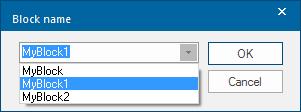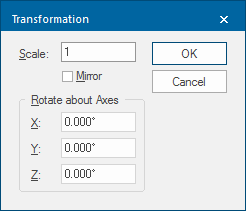Insert Block
Insert Block places an instance of a Block on the current editable overlay. This creates an Insert item.
Once a Block has been defined in a dataset, multiple references to it can be inserted anywhere within that dataset. These insertions are items in their own respect and are called Insert items.
If you have a complicated shape which is repeated many times within a dataset then using a single Block and many Insert items is more efficient.
Note: See Blocks for more information.
1. Select CAD > Insert Block.

2. Now select a Block name from a drop-down list of available Blocks:
3. Click OK. This will place an Insert item containing the Block on the cursor.
Positioning the Insert Block
1. To make any scale, mirror or rotation changes to the Insert Block, press Enter. You will see a Transformation dialog. (If there are no changes, go straight to Step 2.)
| Option | Description | |
|
Scale |
Enlarges or reduces the items on the cursor by the specified value. This value is relative to its current size, and ignores any previous enlargement or reduction. |
|
|
Mirror |
Creates a mirror image of the graphics on the cursor, using the specified angle as the mirror plane. 0 degrees is horizontal, 45 degrees is bottom-left to top-right, and 90 degrees is vertical. | |
|
Rotate about Axes |
Defines three-dimensional rotation around the X or Y-axis. These options are only useful in 3D modelling.Z - Rotates the items on the cursor through the specified angle. Positive angles are anti-clockwise, negative angles are clockwise. | |
2. Click the left-button at the required position of the origin of the Insert Block, or type the coordinate to position it.
3. Moving the cursor will now rotate the Insert Block about its origin.
4. Click the left-button a second time to position the Insert Block.
Using blocks with the clipboard
You can use the Clipboard to cut, copy and paste Block object insertions, i.e. Insert items, from one overlay dataset to another.
If a Block object of the same name does not exist in the destination dataset, one will be created.
If a Block of the same name does exist in the destination dataset, an Insert item will be placed. However it will look like the existing Block object of that name.